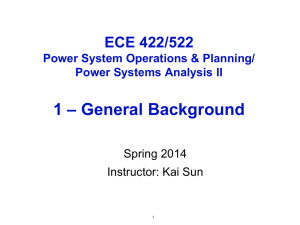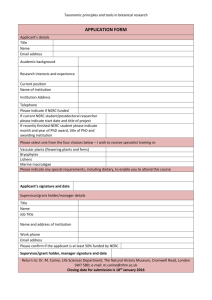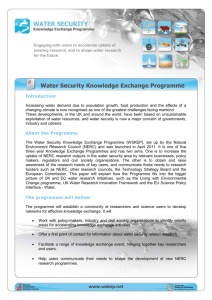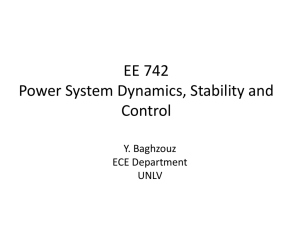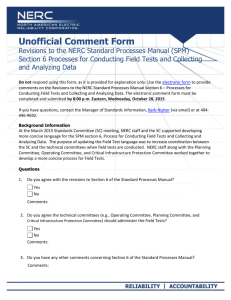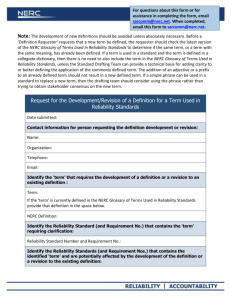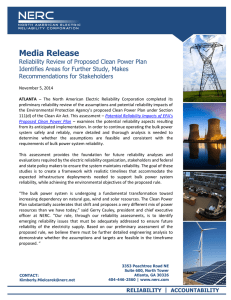ECE 422 Power System Operations & Planning 1 – General Background
advertisement
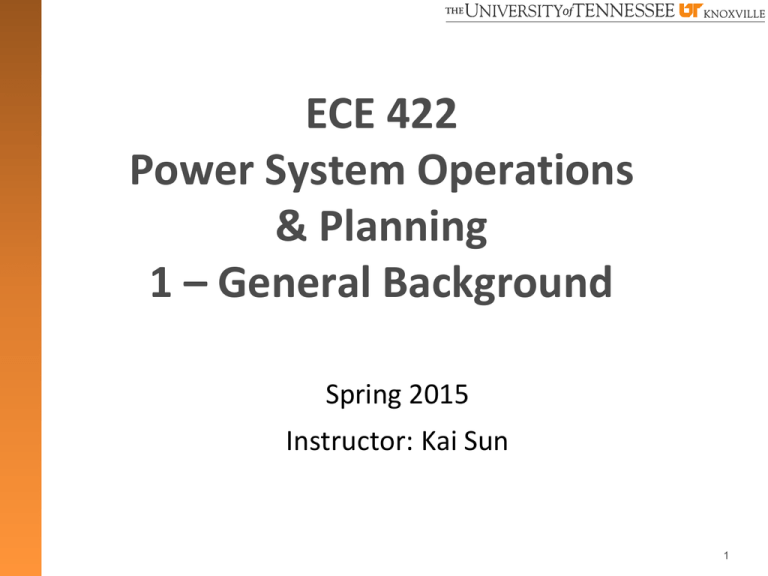
ECE 422 Power System Operations & Planning 1 – General Background Spring 2015 Instructor: Kai Sun 1 Outline •Overview of power system reliability and NERC guidelines •Introduction of power system stability (basic concepts, definitions and examples) •Materials – Part I (Chapters 1&2) of Kundur’s book – Glossary of Terms Used in NERC Reliability Standards, Dec 21, 2012 – IEEE/CIGRE Joint Task Force on Stability Terms and Definitions, “Definition and Classification of Power System Stability,” IEEE Transactions on Power Systems, Vol. 19, No. 2., pp. 1387 – 1401, May 2004 2 Structure of an AC Power System • Generation – Low voltages <25kV due to insulation requirements • Transmission system – Backbone system interconnecting major power plants (11~35kV) and load center areas – 161kV, 230kV, 345kV, 500kV, 765kV, etc. • Sub-transmission system – Transmitting power to distribution systems – Typically, 35/69kV138kV • Distribution system – Typically, 4kV-34.5kV Source: Green Transmission Efficiency Initiative: A Series of Workshops. EPRI PID 1019531, 2009. 3 Bulk Power System (Bulk Electric System) • NERC definition – The bulk electric system is a term commonly applied to the portion of an electric utility system that integrates “the electrical generation resources, transmission lines, interconnections with neighboring systems, and associated equipment, generally operated at voltages of 100 kV or higher.” – Radial transmission facilities serving only load with one transmission source are generally not included in this definition • For short, a bulk electric system is the part of the transmission/subtransmission system connecting – power plants, – major substations, and – HV transmission lines • Most of power system reliability concerns are about bulk electric systems 4 NERC (North American Electric Reliability Corporation) • As a non-government organization, formed by the electric utility industry in 1968 to promote the reliability of bulk power systems in North America. • Initially membership was voluntary and member systems followed the reliability criteria for planning and operating bulk power systems to prevent major system disturbances following severe contingencies • As of June 2007, FERC (U.S. Federal Energy Regulatory Commission) granted NERC the legal authority to enforce reliability criteria with all users, owners, and operators of the bulk power systems in the U.S. • NERC Membership is now mandatory and member systems comply with NERC’s Reliability Standards (approved by FERC) to both promote reliable operations and to avoid costly monetary penalties if caught non-compliant. Every system operator should read, understand and follow NERC’s Reliability Standards. (Visit http://www.nerc.com for more information on NERC.) 5 NERC Functional Model Diagram 6 7 NERC Balancing Authorities • EI has about 90 BAs, which range in load size up to 130GW peaks • WI (WECC) has about 30 BAs. • ERCOT and Hydro Quebec are each operated as single BAs. 8 Reliability of Bulk Power Systems •Power systems should be built and operated to ACHIEVE A RELIABLE ELECTRIC POWER SUPPLY AT THE MOST ECONOMICAL COST •Reliability is defined using two terms: – Adequacy (planning): The ability of the electric systems to supply the aggregate electrical demand and energy requirements of their customers at all times, taking into account scheduled and reasonably expected unscheduled outages of system elements. – Security (operation): The ability of the electric systems to withstand sudden disturbances such as electric short circuits or unanticipated loss of system elements 9 Reliability of Bulk Power Systems (cont’d) •Important requirements of a reliable electric power service – Voltage and frequency must be held within close tolerances – Synchronous generators must be kept running in parallel with adequate capacity to meet the load demand – Maintain the “integrity” of the bulk power network (avoid cascading outages) – Others 10 Example of NERC’s Reliability Standards: Performance under Normal and Emergency Conditions 11 Summary of NERC Contingencies Category Description Stability Loss of load A No contingencies Yes No B N-1 (loss of 1 element) Yes No C Loss of ≥2 elements (local events) Yes Planned or controlled D Extreme events (loss of a transmission path, substation, power plant or major load, cascading outages, etc.) Selecting contingencies for evaluation 12 Contingencies to be studied •Normal Design Contingencies (Categories A, B and C) – Have a significant probability of occurrence – Following any of these contingencies, the system is secure (stability is maintained, and voltages and line and equipment loadings are within applicable limits. ) • All facilities are in service, or • A critical generator, transmission circuit, or transformer is out of service, assuming that the area generation and power flows are adjusted between outages by use of a reserve. •Extreme Contingencies (Category D) – After the analysis and assessment of selected extreme contingencies, measures are developed to reduce the frequency of occurrence of such contingencies or to mitigate the consequences that are indicated by the simulations of such contingencies 13 NECR Contingencies Unlikely but with Extreme Impacts Not Existing in Well-designed Systems • Most utilities manually select NERC Category D contingencies to simulate: o Loss of a key substation High Consequences o Loss of tie lines o Outages close to a generation/load pocket D Low C B Needless to study A Credible and Acceptable Generator Outage N-1 Line Outage N-2 Line Outage Low High Frequency of Occurrence Extreme Events Frequency may increase when system is stressed (e.g. Storm Approaching) 14 How are reliability standards used? •In Planning: – Reliability standards should never be violated in designing the system. •In Operations: – Reliability standards should never be intentionally violated – Sometimes, violations occur due to mis-operations or delayed awareness of the real-time situation 15 Related Terms •Operating quantities: Physical quantities (measured or calculated) that can be used to describe the operating conditions of a power system, e.g. real, reactive and apparent powers, RMS values/phasors of alternating voltages and currents. •Steady-state operating condition of a power system: An operating condition of a power system in which all the operating quantities that characterize it can be considered to be constant for the purpose of analysis. 16 •In designing and operating an interconnected power system, its dynamic performance subjected to changes (i.e. contingencies, small or large) is considered •It is important that when the changes are completed, the system settles to new operating conditions without violation of constraints. •In other words, not only should the new operating conditions be acceptable (as revealed by steady-state analysis) but also the system must survive the transition to those new conditions. This requires dynamic analysis. 17 Related Terms (cont’d) • Disturbance: a sudden change or a sequence of changes in one or more parameters or operating quantities of the power system. • Small disturbances vs. large disturbances – a small disturbance if the equations describing the dynamics of the system may be linearized for the purpose of accurate analysis, e.g. a load change. (We don’t care what that disturbance is) – a large disturbance if the equations that describe the dynamics of the system cannot be linearized for the purpose of accurate analysis, e.g. a short circuit and loss of a generator or load. (We do need to know what exactly that disturbance is in order to estimate the following system trajectory) P(δ) P δ 18 Related Terms (cont’d) •Synchronous operation: – A machine is in synchronous operation with another machine or a network to which it is connected if its average electrical speed (=ω⋅p/2) is equal to the electric speed of the other machine or the angular frequency (ω) of the ac network. – A power system is in synchronous operation if all its connected synchronous machines are in synchronous operation with the ac network and with each other. •Asynchronous operation: loss of synchronism or out of step 19 Stability of a Dynamical System Consider a nonlinear dynamical system Assume origin x=0 is an equilibrium, i.e. The equilibrium point x=0 is stable in the sense of Lyapunov such that In other words, the system variable will stay in any given small region (ε) around the equilibrium point once becoming close enough (δ) to that point. x δ ε 20 Power System Stability • Power system stability is the ability of a power system, for a given initial operating condition, to regain an acceptable state of operating equilibrium (i.e. the new condition) after being subjected to a disturbance • Considering an interconnected power system as a whole – The stability problem with a multi-machine power system is mainly to maintain synchronous operation of the machines (generators or motors) • Considering parts of the system – A particular generator or group of generators may lose stability (synchronism) without cascading instability of the main system. – Motors in particular loads may lose stability (run down and stall) without cascading instability of the main system. 21 Some Terms Related to System Dynamic Performance Secure (vs. Insecure) Stable Oscillatory Secure Not violating given security criteria Stable (vs. Unstable) A system is able to regain an equilibrium following a disturbance. (A stable power system may not be secure if the equilibrium or the transition to the equilibrium violates security criteria) Oscillatory An operating quantity repetitively changes at some frequency around a central value (equilibrium). (When oscillation becomes uncontrollable to damage generators and other equipment, the system will become insecure and even unstable) 22 Example: FIDVR (Fault-Induced Delayed Voltage Recovery) NERC/WECC Planning standards require that following a Category B contingency, • voltage dip should not exceed 25% at load buses or 30% at non-load buses, and should not exceed 20% for more than 20 cycles at load buses • the post-transient voltage deviation not exceed 5% at any bus 23 Stability Classification •Power system stability is essentially a single problem; however, the various forms of instabilities that a power system may undergo cannot be properly understood and effectively dealt with by treating it as such. •Because of high dimensionality and complexity of stability problems, it helps to make simplifying assumptions to analyze specific types of problems using an appropriate degree of detail of system representation and appropriate analytical techniques. •Analysis of stability, including identifying key factors that contribute to instability and devising methods of improving stable operation, is greatly facilitated by classification of stability into appropriate categories 24 Stability Classification • IEEE/CIGRE Joint Task Force on Stability Terms and Definitions, “Definition and Classification of Power System Stability,” IEEE Trans. on Power Systems, Vol.19, No.2., pp. 1387-1401, May 2004. •The classification of power system stability considers: – The physical nature of the resulting mode of instability as indicated by the main system variable (angle, frequency or voltage) in which instability can be observed. – The size of the disturbance (small or large) considered, which influences the method of calculation and prediction of stability. – The devices, processes and time span that must be taken into consideration in order to assess stability. Typical ranges of time periods • Transient or short-term: 0-10s • Mid-term: 10s to several minutes • Long-term: several to tens of minutes 25 Stability Classification Physical nature Disturbance size Time span 26 Rotor Angle Stability • Rotor Angle Stability refers to the ability of synchronous machines of an interconnected power system to remain in synchronism after being subjected to a disturbance. • Phenomenon of instability: increasing angular swings of some generators leading to their loss of synchronism with others. • It depends on the ability to maintain/restore equilibrium between electromagnetic and mechanical torques of each synchronous machine in the system. 27 Rotor Angle Stability (cont’d) For a simple power system consisting of a generator tied to a load bus, only when both sides have rotating mass, rotor angle stability can be a concern 28 “Dynamic Stability” •The term “dynamic stability” also appears in the literature as a class of rotor angle stability. – In the North American literature, it has been used mostly to denote small signal stability. – In the European literature, it has been used to denote transient stability. •Both CIGRE and IEEE have recommended that it not be used. 29 Voltage Stability • Voltage stability refers to the ability of a power system to maintain steady voltages at all buses in the system after being subjected to a disturbance from a given initial operating condition. • The term voltage collapse is also often used. It is the process by which the sequence of events accompanying voltage instability leads to a blackout or abnormally low voltages in a significant part of the power system. 30 Relationship between rotor angle instability and voltage instability • Typical systems vulnerable to two stability problems – Rotor angle stability – Voltage stability • However, two problems often occur together – For example, as rotor angles between two groups of generators approach 180o, the loss of synchronism causes rapid drop in voltages at intermediate points in the network. – Loss of synchronism of some generators may result from the outages caused by voltage collapse or from operating conditions that violate generator field current limits 31 System Operation • Establish most economical operating conditions under “normal” circumstances • Operate the system such that if an unscheduled event occurs, it does not result in uncontrolled (or cascading) outages • Establish “Safe Operating Limits” for all situations • Meet reliability criteria – Voltage limits – Line and component loading limits (thermal limits) – Stability – Dynamic performance 32 Transition due to disturbance Transition due to control action Normal Secure with sufficient margin; able to withstand a contingency Preventive control Alert Secure with insufficient margin; Contingency may cause overloading Corrective control Restorative Emergency control Emergency Insecure; system is still intact Restorative control Extreme Power outages; system separates Cascading events 33 Design and Operating Criteria for Stability Design and operating criteria play an essential role in preventing major system disturbances following severe contingencies. •The use of criteria ensures that, for all frequently occurring contingencies (i.e. credible contingencies, e.g. Categories B and C), the system will, at worst, transit from the normal state to the alert state, rather than to a more severe state such as the emergency state or the extreme state. •When the system enters the alert state following a contingency, operators can take actions to return the system to the normal state. 34 Structure of a Power System and Associated Controls 35 Homework #1 • Learn the IEEE paper “Definition and Classification of Power System Stability” • Select 1 journal/conference paper published by IEEE since 2010 that introduces or addresses some stability problems – Source: http://ieeexplore.ieee.org or http://scholar.google.com – Keywords: e.g. “power system” + “stability” or “control” – The paper should be about bulk power systems, not microgrid or distribution systems • Write a 1-2 pages essay (not Q&A’s): – Title, authors, source of the paper – Background: • What stability problem is concerned? (Which IEEE categories?) • Why is the problem significant? (Any real-world stories?) – Approach • What new approach or technique is proposed? (Outline of the procedure or steps) • How does the new approach perform? – Remark • Any conclusions from the work, or any room for further work • Give a 3-5 minutes talk on your chosen paper and hand in your essay in the class of Jan 20 (Tuesday). Please email me the paper title by Jan 19 (Monday) 5pm 36

